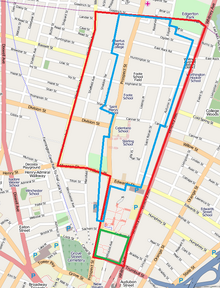This is an old revision of this page, as edited by Polaron (talk | contribs) at 16:37, 7 September 2010 (refocus article). The present address (URL) is a permanent link to this revision, which may differ significantly from the current revision.
Revision as of 16:37, 7 September 2010 by Polaron (talk | contribs) (refocus article)(diff) ← Previous revision | Latest revision (diff) | Newer revision → (diff)| It has been suggested that Prospect Hill Historic District (New Haven, Connecticut) be merged into this article. (Discuss) Proposed since February 2010. |

Prospect Hill is a mostly residential neighborhood and historic district of the city of New Haven, Connecticut. It is located in the north central portion of the city, directly north of Downtown New Haven and the main campus of Yale University. The neighborhood contains Albertus Magnus University as well as the Science Hill area of Yale University. The neighborhood is situated on a hill that is bisected north to south by Prospect Street, the main thoroughfare of the neighborhood. The City of New Haven defines the Prospect Hill neighborhood planning zone to be the region bounded by the town of Hamden in the north, Winchester Avenue in the west, Munson Street/Hillside Place/Prospect Street in the southwest, Trumbull Street in the south, and Whitney Avenue in the east. Prospect Street is the main thoroughfare through the neighborhood. The neighborhood planning zone includes the Hillhouse Avenue area and the Yale Peabody Museum.
The Prospect Hill Historic District is a 185-acre (75 ha) historic district that is significant primarily for its architecture. The historic district includes major collections of Queen Anne architecture, Shingle Style architecture, Colonial Revival architecture, and Tudor Revival architecture. Numerous other styles are also represented. Architects and firms represented include Boston's Peabody and Stearns and R. Clipston Sturgis; New York's Grosvenor Atterbury, Don Barber, J.C. Cady & Co., George S. Chappell, Delano & Aldrich, Ewing & Chappell, James Gamble Rogers, Rossiter & Muller, and Heathcote Woolsey; Philadelphia's Mantle Fielding; Connecticut's Henry Austin and numerous others.
The Prospect Hill Historic District includes major collections of Queen Anne architecture, Shingle Style architecture, Colonial Revival architecture, and Tudor Revival architecture. Some of the more significant properties are listed below.
- Anna L. Graves House, a Queen Anne c. 1890 house at 35 Autumn Street
- Silk House, Colonial Revival, c. 1915, at 75 Autumn Street, designed by architects Brown & VanBeren
- 152, 166 and 180 East Rock Road, three Shingle style houses
- 259-61, 262, 266, 269, 270-272, and 278 Canner Street, six Colonial Revival houses, c. 1900-1910
- Celentano Public School, 370 Canner Street, Victoria, originally built as Yale's first observatory
- 80 Cliff Street, a Queen Anne house, c. 1890
- Ellsworth Foote House at 145 East Rock Road, and 152, 166, 180 East Rock Road, four Shingle Style houses
- 149 and 156 East Rock Road, two Queen Anne houses
- 237 East Rock Road, Colonial Revival with Federal details, c. 1910, former home of Yale University president A. Whitney Griswold
- Othniel C. Marsh House, home of prominent 19th-century paleontologist (listed as a National Historic Landmark)
- Connecticut Agricultural Experiment Station, 123 Huntington St., home of the first agricultural experiment station in Connecticut (listed as a National Historic Landmark)
The Prospect Hill Historic District excludes Yale University's relatively modern buildings on Science Hill as well as several Yale graduate student housing facilities (the Whitehall Apartment Complex, the Mansfield Apartments, and the Esplanade Apartments).
Other historic districts
In addition to the main Prospect Hill Historic District, the neighborhood planning zone includes the Hillhouse Avenue Historic District, an area adjoining Downtown New Haven south of Science Hill, and part of Edgerton Park. Because the neighborhood planning zone eastern boundary runs along Whitney Avenue, a row of houses on the west side of the Whitney Avenue Historic District of East Rock is technically also within the neighborhood planning zone.
Demographics
The residential part of the neighborhood roughly corresponds to census tract 1418.. Census tract 1418 excludes the portion officially within Yale University. As of the 2000 census, the total population of census track 1418 was 4,052. Of the population, 43.02% identified as White, 32.33% as Black, 0.20% as Native American, 19.55% as Asian, 0.10% as Pacific Islander, 2.07% as some other race, and 2.74% as two or more races. Of the total population of any race, 4.94% identified as being Hispanic or Latino, while 11.77% identified as being of Chinese ethnicity.
References
- Prospect Hill (PDF) (Map). New Haven City Plan Department. Retrieved 2009-02-06.
- A small row of properties on the west side of Prospect Street south of Hillside Place is technically within the Dixwell neighborhood planning zone.
- ^ Susan Ryan (January 5, 1979). "National Register of Historic Places Inventory-Nomination: Prospect Hill National Register District / Prospect Hill (pages 1-65 of combined PDF)" (PDF). National Park Service. and Accompanying 12 photos, from 2002 (photo captions at page 79 of text document)
External links
- Prospect Hill Historic District, New Haven Preservation Trust website (text excerpt from NRHP nomination, plus gallery of 12 photos)
| Neighborhoods of New Haven | |
|---|---|
| West | |
| Central | |
| East | |
| U.S. National Register of Historic Places | |
|---|---|
| Topics | |
| Lists by state |
|
| Lists by insular areas | |
| Lists by associated state | |
| Other areas | |
| Related | |